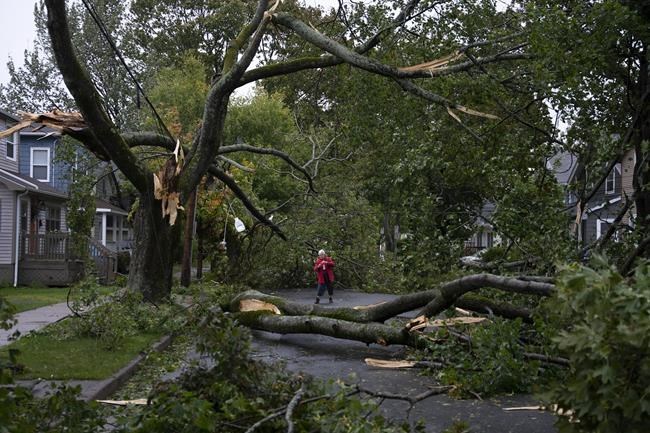A day after post-tropical storm Fiona left a trail of destruction through Atlantic Canada and eastern Quebec, residents of a coastal town in western Newfoundland continued to pick through wreckage strewn across their community, easily the most damaged area in the region.
Photos posted on Sunday from Port aux Basques show homes and outbuildings smashed or submerged on the shoreline, the result of a record-breaking storm surge that swamped a residential neighbourhood.
Mayor Brian Button said the damage to the town of 4,000 was worse that first thought.
"The weather may have cleared, but the situation has not cleared at all," he said via Facebook. "This is not a one day, we can all go back to normal. Unfortunately, this is going to take days, could take weeks, could take months in some places."
As Fiona descended on the town Saturday, churning out 130-kilometre-per-hour gusts, police received reports that two women had been swept into the ocean as their homes collapsed under the weight of the invading storm surge. One woman was rescued by local residents, but the status of the second woman was unclear.
The RCMP confirmed Sunday they are searching for a 73-year-old woman.
"The woman was last seen inside the residence just moments before a wave struck the home, tearing away a portion of the basement," the Mounties said in a statement. "She has not been seen since."
Meanwhile, Nova Scotia Premier Tim Houston was expected to survey some of the hardest hit areas of Cape Breton, where Fiona's wrath left many homes badly damaged.
Despite downed trees and widespread power outages, some Cape Breton residents decided to carry on with milestone events Sunday.
Samantha Murphy, 35, said she was going to proceed with her wedding at a church in downtown Sydney, followed by a reception meal prepared by a caterer with a generator.
Sitting in a hotel lobby with her three bridesmaids, she was wrapping floral arrangements and waiting for her hairdresser to arrive as she contemplated the impact of Fiona's brief but unwelcome visit.
“I think it’s going to be more romantic with candlelight," she said in an interview. "We're going back to when there was no power. Our family is around and let’s celebrate our love."
Murphy said she was determined to proceed with the wedding ceremony on Sunday after the COVID-19 pandemic forced her to cancel previous plans.
In Reserve Mines, about 15 kilometres east of Sydney, Darren MacKinnon was cutting up fallen trees, some of which had landed on nearby homes.
"Glace Bay and Reserve Mines look like a war zone," he said of the two Cape Breton communities. "Houses with roofs ripped off, trees down .... I know Cape Bretoners will help out their friends and family as much as they can."
George MacDonald, a former councillor with the Cape Breton Regional Municipality, said five trees fell on his home as the storm raged.
"We’re lucky in a way," he said. "The windows stayed. Maybe the positive is the trees fell on the house and protected the windows."
Two doors down, neighbour Reggie Boutilier lost part of his roof and his shed was torn apart.
"The wind was very high coming through here," the 67-year-old tech worker said as he prepared to install some plastic sheathing. "It was just catching the peak of the house all night. The force was incredible."
On the north shore of Prince Edward Island, another area ravaged by Fiona, lobster buyer Leigh Misener pointed to what was once his office on the Covehead Wharf.
On Sunday morning, it lay upside down about three kilometres away on a front lawn.
"That’s our building," Misener said with a laugh. "Stop by anytime."
Despite his wry humour, he said it was heartbreaking to see the destruction. The wharf is now an ugly vision of smashed buildings and upturned soil, as if an earthquake shook the place. Where the buildings once stood now lies a foundation littered with weights used for lobster traps and an anchor sitting in the rubble.
"The whole wharf's gone," Misener said. "Everyone's going to hurt from it."
Judy Profitt, who lives a few kilometres away on Brackley Beach, pointed to the Covehead Bridge and a now absent landmark — a small dune that once stood next to the bridge.
"It's my favorite dune, but it's just been sheared off," Profitt said, her voice breaking with emotion.
"I had taken a picture of that dune. After my husband died, (it was) laser-etched on his tombstone. To look at that dune now, it's just such a sad sight."
In eastern Quebec, officials were heading to the storm-battered island chain of Îles-de-la-Madeleine, where high winds and storm surges caused flooding and road closures.
Provincial Public Security Minister Geneviève Guilbault confirmed that 30 and 40 people were forced to leave their homes, but no one was hurt.
"We're going into recovery mode," she told reporters in Quebec City.
Guilbault said one of two underwater telecommunication cables linking the islands with the mainland — dubbed COGIM 1 — was damaged by Fiona, but she said the other remained intact.
Guilbault said the Quebec government has worked hard to lessen the impact of storms that have worsened with climate change, saying millions of dollars have been invested in slowing coastal erosion.
"As it's an island, the problem is fairly chronic around the island and in eastern Quebec in general," she said.
As for Fiona, the big storm moved into southeastern Quebec on Sunday, with Environment Canada saying it will continue to weaken as it tracks across southeastern Labrador and over the Labrador Sea.
— With files from Michael Tutton in Sydney, N.S., Hina Alam in Covehead, P.E.I., and Morgan Lowrie in Montreal.
This report by The Canadian Press was first published Sept. 25, 2022.
Michael MacDonald, The Canadian Press




